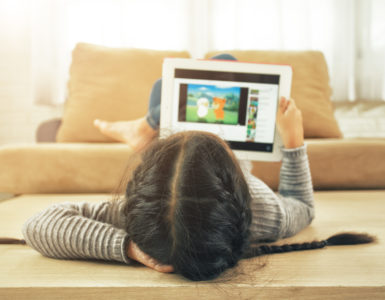By Liana Cannon and Joyce Sibbett
During this unusual time when children are spending more time at home with parents who are often working from home, it can be difficult to find ways to constantly keep kids entertained and educated. We find ourselves delving into YouTube for brain teasers, reaching for online games to stay sane, and whipping out Netflix and Disney Plus to fill in everything in between.
Screen time seems to be a natural way to engage young children. However, this engagement is often overused and less productive than unstructured play time. So, we reached out to Joyce Sibbett, President of Dancing Moose Montessori School, to give us some advice on how to make the most of screen time now that it seems to be the go-to solution for everything.
Here are some important points to consider as you structure your screen time:
Establish Limitations
First and foremost, parents should set up rules for when the television will be turned off to help children anticipate their expectations. This is especially important now when kids have the option to spend all day on TV if they aren’t monitored! Television can be a great bonding activity, but limitations help them explore other means of entertainment as well. You might consider setting limitations of not just when screen time is allowed, but where screens are allowed and what media can be consumed for different ages and different times of the day.
Consider Age Appropriateness
Not all screen time is created equally. The younger your child is, the less screen time is appropriate. Even though a nice variety of educational apps can stimulate your child, parents need to be involved and engaged enough to discuss what their young child (especially children under 5) are watching. Keep in mind, screens emit blue light, which researchers have shown can throw off circadian rhythms. Children should not be engaged in screen time for at least one hour prior to bedtime.
Define ‘Screen Time’
Sometimes we think of ‘screen time’ as just the leisure time we sit our kids in front of technology. We need to remember that ‘screen time’ is any time kids are on the screens, for any reason. Many educators are reaching for technology to teach lessons and interact with students. For instance, Zoom conferences are a wonderful way for children to touch base with their teachers and fellow classmates for some online learning time. It’s one of the best technological connection devices and one we utilize daily at Dancing Moose. However, although these are amazing tools, they need to be considered ‘screen time’ and should be factored into the overall screen time limits for the day.
Initiate Family Conversation
If children are watching an educational show or simply a fun program with the family, an extended conversation about the show and the content they are consuming makes screen time much more meaningful. Pull out the snacks, push pause and discuss, ask questions about what they learned or what they thought. If you are not watching a program with your child, make sure that you have reviewed and approve of the content.
Incorporate Movement
Being in front of a TV or electronic device doesn’t necessarily mean laying on the couch or mindlessly scrolling for hours. Using screen time to engage in movement such as yoga and mindful activities can be a nice addition to children’s activities. Often, they will enjoy singing along with familiar music videos, or dancing along with a movie! But keep in mind, even these activities need to have a proper time limit.
No matter the time limits you set, the mediums you choose, or the content you allow, the most important concept to incorporate in your child’s screen time structure is your own involvement. Parents should be as involved as possible with the programs their children are watching. This means helping them choose appropriate content, discussing shows with them, and enforcing limitations. Screen time limitations are crucial to allow for play time, which is really the key to children’s development. The more children understand the schedule for when screen time will end, the easier it will be for them to make the transition to play time. Play that engages children’s minds in creative, imaginative activities will be powerful in developing lasting social and cognitive skills.















Add comment